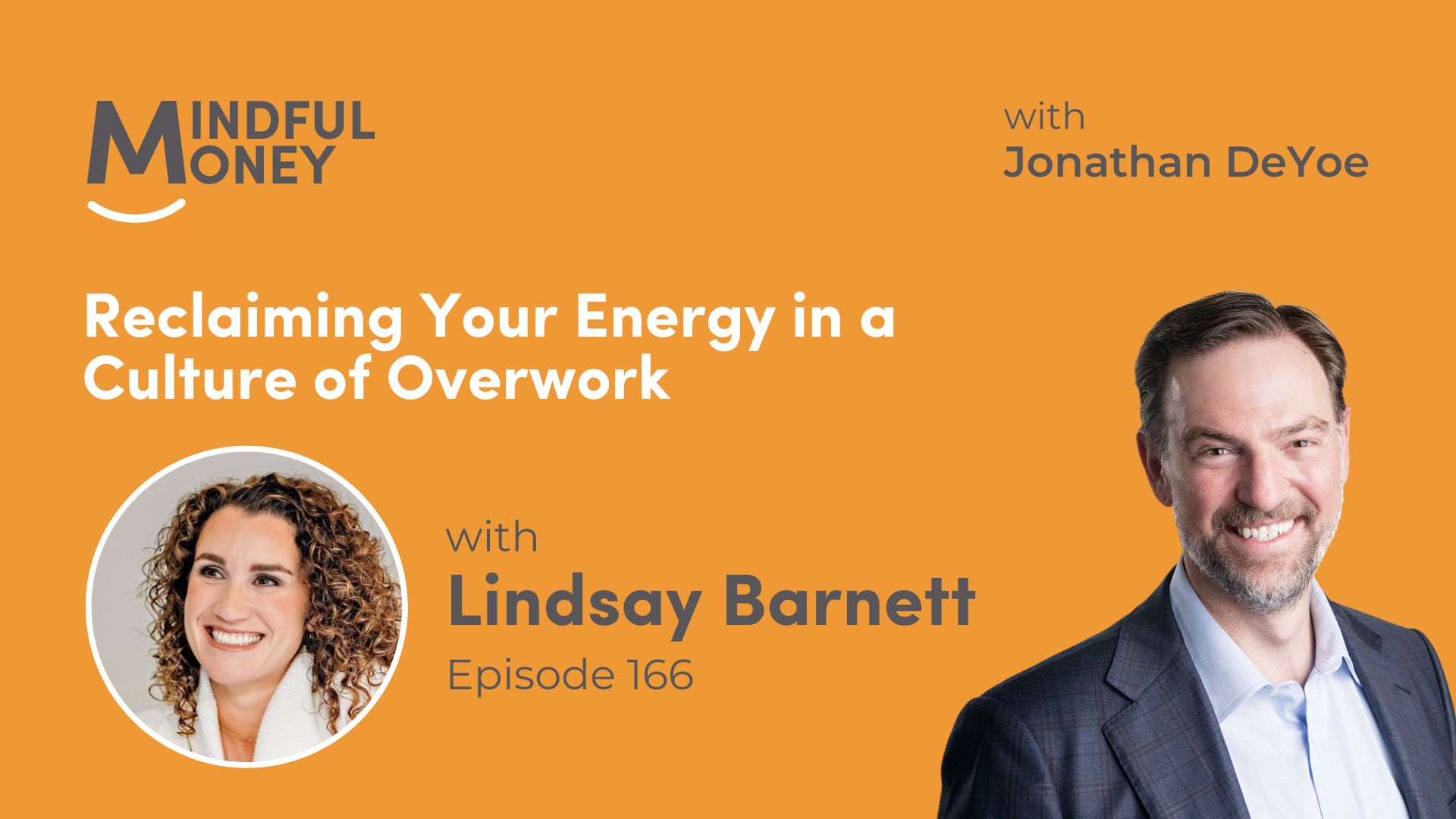This blog is the eighth of a 10-part series which covers everything you need to know to get started on your path to financial freedom:
1. The First Step in Any Financial Plan is NOT What You Think. We Start by Knowing What is Worth Seeking.
2. Developing Your Vision of a Perfect Life
3. Adopt a Savings Habit
4. Emergency Fund Basics
5. Eliminate High-Interest Debt
6. Saving and Investing for Retirement
7. Paying Down Low-Interest Debt and Building Taxable Savings
8. Simple, Basic, Mindful Investing
9. The Final Step – Portfolio Optimizers
10. The 10 Core Beliefs of Mindful Investors
After he had been a client for half a dozen years, Mark approached me at a client event:
“I’ve listened to your January “Forecast” and your July “Half-Time Report” for 5 years and I finally understand what you do. We hired you to manage our investments, but I have finally concluded that you are managing us.
“You helped us build a portfolio of appropriate investments perfectly suited to our life plans and the next day you commenced to prevent us from over-managing them. We revisit the plan annually, but the prevention requires near constant attention and communication.”
Precisely.
During my first 10 years in the industry, I personally tried every imaginable way to invest. In the end, I determined that I cannot predict or control the short-term outcomes of investments. Period. Full stop.
And no one else can either.
My approach to investing my own money and my clients’
money comes out of this experience, and has been verified by reems of academic evidence, and is modeled after a long list of humble advisors I have known over the years.
Great fiduciary advice is a progression. We help clients:
- Express their values in terms of prioritized time-specific goals.
- Create dollar-specific plans to reach those goals (inflation-adjusted).
- Build a savings plan & portfolio process with the highest probability of bringing the goals to fruition in the time allotted.
- Filter the noise (from the punditry and their own thoughts) and avoid rash decisions.
Numbers 1, 2, and 4 are the most difficult and time-consuming; number 3 gets all the attention.
Once you get the goals(1) and plans(2) right, the portfolio(3) is very easy. Once you have the portfolio in place, it doesn’t change unless the goals and plans change first.
It’s not just that we don’t change the portfolio in response to changing market or changing economic scenarios. It’s that we meet, with wisdom and compassion, our clients’ near constant desire to tweak and optimize things that cannot be tweaked or optimized.
We don’t manage investments, we manage people.
However, in our market-focused and performance-driven culture, many advisors and most clients still believe that the “expertise” we provide has something to do with prediction – better market timing and/or improved security selection.
No Prediction Zone
There is no escaping 4 fundamental investing truths:
- Economies and markets are inherently unpredictable in the short-term.
- Unpredictability doesn’t stop those trying to predict.
- Some who try will get it right and scream from rooftops.
- Those who get it right are lucky, not skillful.
In the short-term, it is all speculation. It is all a crapshoot. An individual investment for a short period of time can be tossed about by all manner of unexpected occurrences. There is no predictability. We cannot manage risk or return in the short-term… so we let it go.
All successful long-term investors are continuously acting on a plan that is founded on their deeply personal values and goals. They are appropriately allocated, they are broadly diversified, and they rebalance regularly. They are patient and remain mindful of their limitations.
All failed investors are continually reacting to yesterday’s headlines and every reaction is a form of prediction.
No one knows what is coming next.
No one knows how markets will react.
We can’t build successful portfolios on the unknowable.
Stop predicting.
Pro-Active Investing – Actions We Embrace
I have always referred to myself and my basic style of financial advice as being goal-focused and planning driven. The portfolio is always long-term, and the portfolio design comes after and is informed by goals and planning. The beauty of this is that I’m focused on levers that can be pulled to improve client outcomes.
Meanwhile, the financial world is short-term, market-focused and performance-driven – it puts the portfolio discussion before goals and planning. They are pulling levers that study after study have shown to be ineffective at improving investment outcomes.
Our simple, basic, mindful investing process is counter cultural. If you embrace three (3) core practices, you don’t need to do anything else with your portfolio. They are necessary and sufficient to providing excellent real life investing outcomes.
1. Asset Allocation
Asset allocation is the strategy of dividing your investments into a mix of different asset classes, with the aim of appropriately balancing risk and reward and increasing the probability of reaching your goals. There are three primary asset classes:
- Equity (individual stocks, equity exchange-traded funds (ETFs) and equity mutual funds);
- Fixed-income (government, corporate and municipal bonds and bond funds); and
- Cash or cash equivalents (Treasury bills, money market funds and bank CDs).
How you should allocate funds to these three asset classes is based on your individual needs, goals, and ability to tolerate volatility (the unpredictable change in price). That means there is no one “right” or “optimal” asset allocation.
The key to choosing a successful asset allocation is to first recognize that each asset class acts in specific ways. Generally, the more stable and predictable an asset, the lower the expected returns. The more volatile an asset, the higher the expected returns.
Equity assets like stocks tend to pay the highest rate of return over time, but are also the most volatile. Owing to this volatility and risk, however, stocks are a reliable source of growth in the long-term.
Fixed-income assets like bonds are often less volatile, and therefore tend to pay lower returns. But they play an important role in your portfolio as a way to mitigate stock volatility.
Cash doesn’t pay much of a return, but it provides liquidity and also helps reduce volatility in your account, since its face value is relatively stable. That stability makes it a vital part of the mix.
The long-term success of your investment portfolio depends more on asset allocation than the success of any particular investment in the account. How you allocate your assets may be the most important investment decision you make.
So, what percentage of your account should you commit to each asset class?
The simple answer: it depends on your goals. Specifically, how much you need and when do you need it for accomplishing your goals. Another crucial element is your ability to tolerate volatility. You want an asset allocation that you’re willing to stick with over the long haul.
I have written extensively about the importance of your equity allocation HERE. Ultimately, everyone must choose an asset allocation designed to generate the long-term returns they need to reach their financial goals.
2. Diversification
There are no facts about the future, and what we think we know is often riddled with tragic shortcuts in reasoning and unconscious bias. Instead of wasting time playing the guessing game of which investment will perform best… own it all. Diversification is the disciplined practice of choosing a variety of investments within each asset class. Diversification keeps you from foolishly putting all your eggs in the wrong basket.
Diversification means you invest in the stocks of companies of a variety of sizes, industries and geographies. You own big and small, growth and value, international and domestic. Personally, I seek out (and recommend) owning the broadest available index in each geography. Own it all.
The same goes within fixed-income –
you buy an index that owns a representative piece of all parts of the fixed income market, from conservative and high-yield, government and corporate, short-term and long, domestic and international.
It is tempting to try to put more money into investments that are performing well and avoid those that are doing poorly. But you don’t know and can’t guess what’s going to be the next hot or cold investment – no one can. By diversifying your portfolio, you will own some portion of the things that are doing well, and at the same time you reduce the damage caused by any catastrophic failures. Diversification steadies your returns and reduces the probability of your experiencing EITHER huge gains or huge losses.
Diversification is the investing equivalent of choosing to be the tortoise in Aesop’s fable. It’s slow, it’s steady… and it wins the race.
All that is left is rebalancing.
3. Rebalancing
We begin our investing journey with a plan-appropriate asset allocation. Over time, our portfolio goes out of balance as certain assets do well and others do less well. Regular rebalancing – the selling of the things that have done well and repurposing of proceeds into things that have done less well – returns your portfolio to its original plan-appropriate asset allocation.
There is a tendency for both unnatural highs and unnatural lows in the markets to snap back to a rising average over time. This process is known as reversion to the mean, and it is entirely unpredictable. By rebalancing periodically, no matter what’s happening in the markets, you create a system that buys low and sells high. The system is immune to human foibles, short-term fads, and investor fears or fantasies that drive irrational market swings.
By rebalancing at specific intervals (such as annually) you automate the buy-low, sell-high process without accidentally plunging into prediction territory.
In the end, there is one downside to diligently practicing asset allocation, diversification and rebalancing: you are never going to knock the investment ball out of the park. But you won’t ever strike out, either. Over the long haul, through zigs, zags and multiple market cycles, you will end up faring better than most.
Let go of the idea of finding the next Amazon or Apple. Let go of all your investment fears. Follow a simple, basic, mindful approach to investing.
It is really that simple. But… it won’t be easy.
Reactive Investing – Actions We Avoid
We know – vividly – what has already happened. We can never know what will come next. The humble recognition and remembrance of this truth should prevent us from reacting. But we WILL be tested.
We Will ENVY Returns We See But Are Not Experiencing.
Sometimes, a small fraction of the investable universe starts getting lots of investor and media attention. Often a new technology (like 3D printing, EV, or AI) or a new investment product (like cryptocurrency, SPACs, or NFTs) captures the collective imagination. The growing attention attracts investors’ dollars, and folks begin overpaying a little at first, and eventually overpaying a lot. The more folks are willing to overpay, the better these companies and their investors (often our neighbor, or brother-in-law) appear to be doing, based on stock price and “returns” alone.
Our attention is then drawn to those returns that our brother-in-law reports his portfolio is achieving – which our own diversified portfolio is not. Feelings of jealousy and missing out (FOMO) move us to sell the holdings in our portfolio that have not been working lately and buy whatever appears to be making our brother-in-law rich.
In hindsight, we can see how well this strategy works:
- The internet stock boom led to a dot.com bust
- CDO’s (Collateral Debt Obligations) led to the Great Recession
- Meme stocks exploded higher and then exploded
- Multiple altcoins created millionaires before going bust
- Pandemic growth darlings became post-pandemic canaries
Large upswings in specific investments very often lead to large collapses in the very same investments. If you’re getting into them because they increased in value, you’re trying to buy other people’s profits – but you are likely overpaying. It is impossible to know how far, or for how long, such episodes will last before they fall apart.
But, we know they will fall apart. This is what is meant by “reversion to the mean.”
We do not buy out of envy.
We Will FEAR Impending Doom.
On the flipside, we may not be motivated by greed at all. We may be losing money, or fear losing money, and decide to sell our current portfolio to “protect” ourselves from this possibility.
This, I hope you can see, doesn’t work any better.
Strangely, the financial punditry reacts to every 10% correction as the end of the world and we broadly accept this reaction as truth. But it isn’t. Such corrections are, as anyone with the slightest sense of market history knows, a common occurrence. The average annual drawdown from peak-to-trough in the S&P 500 is about 14%. Whatever they are screaming about today may ultimately reach that mark. Or it could be more. Or less.
No matter how many people opine on the subject… no one can know, and it cannot be predicted. And, of greater importance to long-term, goal-focused, planning driven investors like us – it does not matter.
You cannot predict your way around market declines. If you cannot ride out a market decline approaching 15% on an almost annual basis – and a decline averaging twice that about twice a decade – you simply should not be invested in equities.
We do not sell out of fear.
Two Mindfulness Practices to Manage My Investing Behavior
We cannot eliminate the fear and envy from our lives. We can however be aware of their prevalence, and attempt to NOT act on them.
When I am caught in the moment and the fear or the envy rises within me, there are two practices I rely on to get me unstuck – a deep breathing exercise for quick relief, and/or a longer body scan exercise for the more challenging scenarios.
Paying attention to your breath is most peoples’ very first mindfulness exercise. It is simple and it’s always available because you are always breathing. In its most basic format, you sit comfortably and attend to your breath. You might say quietly to yourself, “In,” when you breathe in and, “Out,” when you breathe out.
The deep breathing exercise I would recommend has a little bit more structure to it, but only takes 3 minutes. You aren’t just paying attention to your breathing (which can be hard for some people), you actually have something you are doing – counting. This 3-minute exercise will quiet most momentary emotions and repeating thought patterns.
Take a deep in-breath (4 count); hold (4 count); take a full out-breath (4 count); hold (4 count); repeat. If you do this for 10 breaths, the rising emotion (fear or envy) will subside. The emotion will lessen its hold, and you will find yourself calmer.
Or, when it gets really bad and you need a little bit stronger antidote, you can do a body scan. Sit comfortably and breathe normally. Bring your attention to your body. As you scan your body, pay attention to the different sensations – there may be warmth and coolness, pressure where your body contacts the cushion, chair, or floor, you may feel the fabric of your clothes on your skin, perhaps there is a tingle or a pain point.
Start the body scan at the top of your head; feel the hair on your scalp. Scan your awareness down your face – relax your jaw, around your neck, across your shoulders – relax your shoulders, down your chest and stomach – relax your stomach, down one arm, and then the other, back up and then down your back, feel the pressure on your sit bones, scan down your right leg and foot, then your left leg and foot. A body scan can be as slow or as quick as you need. You could spend two quick minutes simply focusing on relaxing your jaw, your shoulders and your belly (the three places we hold the most tension) or you could spend 20 minutes on a thorough scan of every surface and tension point on your body.
These exercises will break the emotion’s hold on your psyche and return you to the experience of the present moment. Becoming embodied in the present moment is a powerful antidote to whatever stories are running through your head.
If the narrative resurfaces as-is, changes slightly, or intensifies… repeat the mindfulness exercises again. Remembering:
- This is a no-prediction zone
- Our three core practices work
- The desire to react is normal
These practices can be applied effectively in the moment. However, to really experience the power of mindfulness on your investing outcomes, try to initiate a daily 10-minute mindful breathing exercise. If you do, you will see the benefits of the practice more clearly.
With practice, you will slowly discover the fear and envy narratives have a harder time grabbing you. You become more quickly aware of them as they take hold, and it becomes easier for you to release them and come back to your present moment awareness.
As you come back to the present moment, you will stop being pulled by predictions, your emotions won’t move you to action, and you will remember the three core practices of simple, basic, mindful investing – asset allocation, diversification, and rebalancing.
The original promise of better investing outcomes and a better investment experience will be yours.






